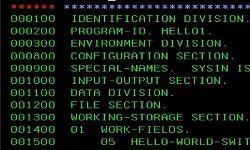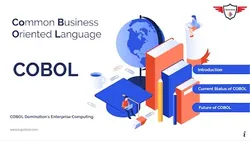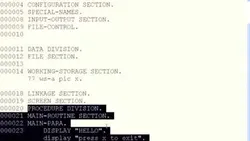
IBM COBOL Data and File Management 
This course provides an introduction to IBM COBOL data and file management. Participants will gain hands-on experience with the fundamental elements of COBOL code, working with COBOL data, handling COBOL files, and using relational databases in a mainframe, COBOL context. Enroll now to take the first step in increasing your knowledge and expertise. ▼
ADVERTISEMENT
Course Feature
![]() Cost:
Cost:
Free
![]() Provider:
Provider:
Coursera
![]() Certificate:
Certificate:
Paid Certification
![]() Language:
Language:
English
![]() Start Date:
Start Date:
24th Apr, 2023
Course Overview
❗The content presented here is sourced directly from Coursera platform. For comprehensive course details, including enrollment information, simply click on the 'Go to class' link on our website.
Updated in [February 21st, 2023]
1. Learn the fundamentals of COBOL code and how to work with COBOL data.
2. Understand how to handle COBOL files and how to use relational databases in a mainframe, COBOL context.
3. Gain hands-on experience with IBM COBOL data and file management.
[Applications]
Students will be able to apply their knowledge of IBM COBOL data and file management to their own projects. They will be able to create and manage COBOL data and files, as well as understand the fundamentals of relational databases in a mainframe, COBOL context. Students will also be able to use their knowledge to troubleshoot and debug COBOL code.
[Career Paths]
1. Mainframe Programmer: Mainframe programmers are responsible for developing, testing, and maintaining software applications on IBM mainframe computers. They use COBOL and other programming languages to create and modify programs that run on the mainframe. Mainframe programmers must have a strong understanding of the IBM mainframe environment and be able to troubleshoot and debug programs. The demand for mainframe programmers is increasing as more organizations move their data and applications to the cloud.
2. Database Administrator: Database administrators are responsible for the design, implementation, and maintenance of databases. They use COBOL to create and modify database structures and to write programs that access and manipulate data. Database administrators must have a strong understanding of database design and be able to troubleshoot and optimize database performance. The demand for database administrators is increasing as more organizations move their data and applications to the cloud.
3. Business Analyst: Business analysts are responsible for analyzing business processes and developing solutions to improve efficiency and effectiveness. They use COBOL to create and modify programs that automate business processes. Business analysts must have a strong understanding of business processes and be able to identify and solve problems. The demand for business analysts is increasing as more organizations move their data and applications to the cloud.
4. Systems Analyst: Systems analysts are responsible for analyzing and designing computer systems. They use COBOL to create and modify programs that automate system processes. Systems analysts must have a strong understanding of computer systems and be able to troubleshoot and optimize system performance. The demand for systems analysts is increasing as more organizations move their data and applications to the cloud.
Pros & Cons

Excellent course content.

Lots of reading material.

Visual Studio setup with COBOL extensions.

Outdated links.

Poor video content.

No meaningful hands on experience.
Course Provider

Provider Coursera's Stats at AZClass
Discussion and Reviews
0.0 (Based on 0 reviews)
Explore Similar Online Courses

Sound Design in UX: An Introduction for Designers

YouTube Video Editing: Develop Your Signature Style

Python for Informatics: Exploring Information

Social Network Analysis

Introduction to Systematic Review and Meta-Analysis

The Analytics Edge

DCO042 - Python For Informatics

Causal Diagrams: Draw Your Assumptions Before Your Conclusions

Whole genome sequencing of bacterial genomes - tools and applications

Mainframe COBOL Tutorial

COBOL


Start your review of IBM COBOL Data and File Management